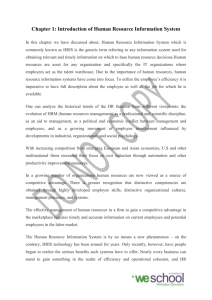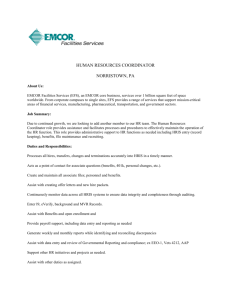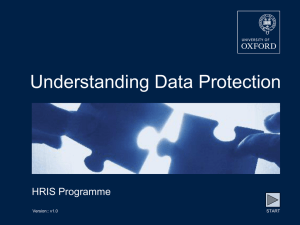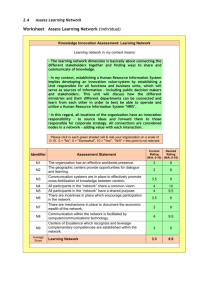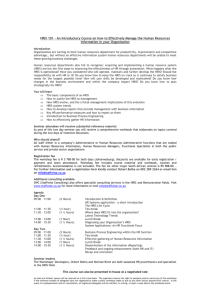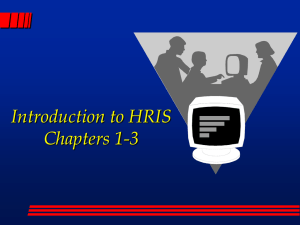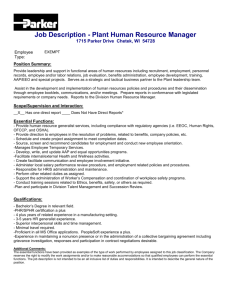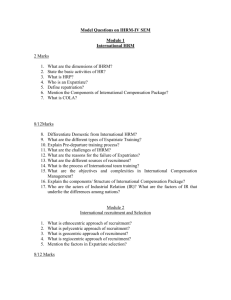An Analysis of Human Resource Information Systems impact on
advertisement
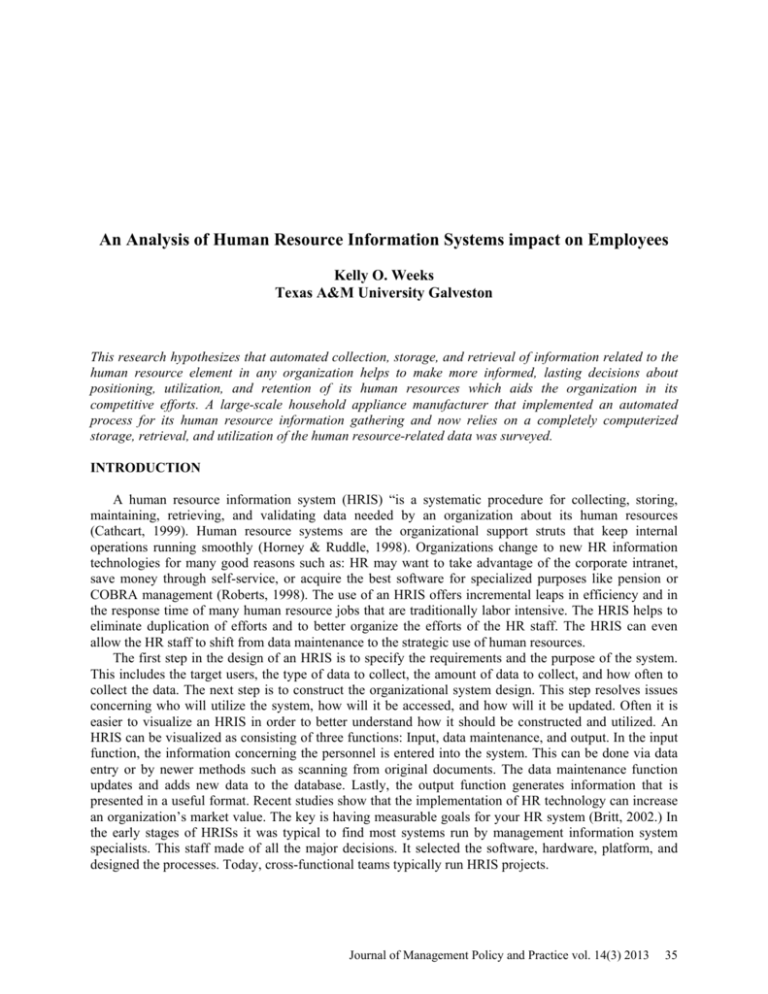
An Analysis of Human Resource Information Systems impact on Employees Kelly O. Weeks Texas A&M University Galveston This research hypothesizes that automated collection, storage, and retrieval of information related to the human resource element in any organization helps to make more informed, lasting decisions about positioning, utilization, and retention of its human resources which aids the organization in its competitive efforts. A large-scale household appliance manufacturer that implemented an automated process for its human resource information gathering and now relies on a completely computerized storage, retrieval, and utilization of the human resource-related data was surveyed. INTRODUCTION A human resource information system (HRIS) “is a systematic procedure for collecting, storing, maintaining, retrieving, and validating data needed by an organization about its human resources (Cathcart, 1999). Human resource systems are the organizational support struts that keep internal operations running smoothly (Horney & Ruddle, 1998). Organizations change to new HR information technologies for many good reasons such as: HR may want to take advantage of the corporate intranet, save money through self-service, or acquire the best software for specialized purposes like pension or COBRA management (Roberts, 1998). The use of an HRIS offers incremental leaps in efficiency and in the response time of many human resource jobs that are traditionally labor intensive. The HRIS helps to eliminate duplication of efforts and to better organize the efforts of the HR staff. The HRIS can even allow the HR staff to shift from data maintenance to the strategic use of human resources. The first step in the design of an HRIS is to specify the requirements and the purpose of the system. This includes the target users, the type of data to collect, the amount of data to collect, and how often to collect the data. The next step is to construct the organizational system design. This step resolves issues concerning who will utilize the system, how will it be accessed, and how will it be updated. Often it is easier to visualize an HRIS in order to better understand how it should be constructed and utilized. An HRIS can be visualized as consisting of three functions: Input, data maintenance, and output. In the input function, the information concerning the personnel is entered into the system. This can be done via data entry or by newer methods such as scanning from original documents. The data maintenance function updates and adds new data to the database. Lastly, the output function generates information that is presented in a useful format. Recent studies show that the implementation of HR technology can increase an organization’s market value. The key is having measurable goals for your HR system (Britt, 2002.) In the early stages of HRISs it was typical to find most systems run by management information system specialists. This staff made of all the major decisions. It selected the software, hardware, platform, and designed the processes. Today, cross-functional teams typically run HRIS projects. Journal of Management Policy and Practice vol. 14(3) 2013 35 Ford Motor Company began to use an HRIS in the early 1980s. The main early challenge to the organization was the transition from the HRIS being controlled by the Information Technology staff to the creation of an HRIS staff. Now that the organization’s system includes information that is vital to many different departments within the organization, the information is viewed as a corporate resource. Due to this factor, the advent of the internet and the increasing need of the information stored in the HRIS by different department within the organization have led the organization to consider moving control back to the Information Technology department (Roberts, 1999). The HROne project at Citigroup involves restructuring the diverse HR operations into a single system. This system will automate processing, eliminate duplicate efforts, and establish one set of policies for the organization. AT&T has undergone a similar metamorphosis that is similar to Citigroup. AT&T has reorganized its HR operations and outsourced most of the functions to AON Human Capital Services. This outsourcing has allowed the HR staff to spend more of its efforts focusing on strategic issues (“How two organizations are achieving HR value”, 2003). The selection of an HRIS is terribly vital to an organization due, in part, to the fact that the organization will typically use the system for a period of at least eight years. The selection process can last from three to nine months. The organization can hire a specialist to recommend a system or the organization can purchase existing software such as SAP or PeopleSoft. It is a good strategy to get the hardware right so that the new system will connect adequately with the existing system and will map data properly and consistently across systems (Roberts, 1998). The move to a web-based system or to a corporate intranet is currently the top cost-cutting strategy at use within organizations that utilize HRISs. The use of these systems improves efficiency within the organization. Other examples include the use of e-mail to communicate HR related information instead of the postal service. Another method is providing self-service HR applications within the organization. This is especially effective in tasks that require much data entry and can be performed directly by the employee. Many smaller organizations struggle with the implementation of an HRIS on a limited budget. The use of application service providers (ASP) has greatly aided the recruitment aspect of the organization. The use of outsourcing can include other areas of the HR function as well. Payroll, relocation services, and FMLA compliance are other functions that can be effectively outsourced. The lack of strategic or operational functionality has been cited as a recurring problem with current HRIS. Insufficient integration with other systems within the organization, complication of the system, inflexibility, and lack of a user-friendly interface are also mentioned. Many organizations struggle with the ability to make information available to employees and to implement HRIS goals within a limited budgetary situation. Another problem facing organizations using HRIS is that of training the staff on its proper and effective use. HR systems of successful firms often display practices reinforcing consistent themes or messages (Baron & Kreps, 1999). The future will witness the rapid expansion of many organizations to utilize electronic HR (E-HR). E-HR can be described as the overall HR strategy that redistributes the HR function throughout the organization and to trusted business partners. E-HR unites HR activities with finance, customer service, and the supply chain. E-HR is very cost effective, especially for small to medium organizations and it also helps to eliminate duplicate data collection. E-HR has been identified as a catalyst toward achieving business strategies. A major deterring factor of these systems has been the costs of implementation and maintenance. By outsourcing, one has access to expert knowledge and services that may be too costly for them to provide themselves. Also, outsourcing E-HR reduces operating costs and large investment risks involved in buying software. Employee self-service (ESS) is one of the newest trends in HRIS. The technology that drives the ESS allows managers to gain direct access to HR databases without the assistance of the HR department. This facilitates the inclusion of HR related information into many organization decisions. To further leverage the value of an HRIS, organizations will come to view the system as a portal to all knowledge for managers and employees. This communication tool will allow employees, vendors, and customers to communicate with one another via the portal. The portal will include job information, tools, data, and news. As technology increases, workflow processes will become smarter. The HRIS could be improved to assist a manager processing performance reviews with prompts related to the real-time evaluation. In addition to this, the use of expert systems to aid personnel will increase. This trend is 36 Journal of Management Policy and Practice vol. 14(3) 2013 already being noticed in law and medicine. In an attempt to further stretch already strained budgets, many organizations are likely to upgrade rather than replace existing software. One of the most exciting new trends in HRIS is the use of wireless HRIS. A wireless HRIS enables managers and employees to access and change their HR data by the use of a web-enabled pocket PC or a cellular telephone. New technology for the future includes the use of wireless PCs, Tablet PCs, and multi-function devices such as IBM’s MegaPad (“Coming soon: wireless HR information systems”, 2002). CONSTRUCT Foundation An HRIS “is a systematic procedure for collecting, storing, maintaining, retrieving, and validating data needed by an organization about its human resources (Cathcart, 1999). Prior to the introduction of computer technology into the organizational mainstream, an employee would submit a paper application to a potential employer. This application would contain typical demographic information that would be stored within a folder that the HR department could access as necessary. Once the employee was hired, pertinent information from the application was also sent to the finance department for payroll purposes. Most employers viewed this information as necessary, but not valuable. One of the computerized information systems first used by American organizations was that found within the personnel department. In the 1950s, select organizations began to install automated payroll systems (Blair, 1988). Because large corporations were the typical users of early HRIS, the initial development of software was directed towards the mainframe computer market. Due to the fact that large employers were the only customers for HRISs, software vendors and HRIS professionals were guided by their needs. At this time, most systems were batched which produced systems that were centralized. The HRIS professional developed into an information technology function whose main concern was to maintain the integrity of the database. As computer technology increased and the cost of computing decreased, the usage of HRISs in organizations became more prevalent (Cottrell & Robertson, 1987). In the 1980s, office automation was initiated in many large corporations. This led to the increased development of HRISs. The emphasis was on developing HRISs very inexpensively. The thought was that people within the HR department could be replaced with software. Instead of having employees maintain extensive records, a technician would enter the information once into a system and update records as necessary. A downside to the new technology was the high price tag associated with the software packages. Typical packages could cost in excess of $200,000. One should first define the business processes to learn what steps are involved and which databases will be accessed. Then ascertain what “middleware” or workflow engine is needed between the new HR system and the legacy system (Roberts, 1998). Benefits The use of an HRIS offers incremental leaps in the efficiency and the response time of many human resource jobs that are traditionally labor intensive. The HRIS helps to eliminate duplication of efforts and to better organize the efforts of the HR staff. Guinn (1998) has shown that organizations that implement one system usually implement another. One key benefit of an HRIS is the ability to consistently develop and manage employees based on the value of an individual’s contribution. Enterprise-wide HR systems can improve an employee’s job productivity by cutting repetitive work and speeding the pace at which manual processes are managed (Horney & Ruddle, 1998). This software provides a ready application that can be linked with the legacy systems. Often, the use of an HRIS relieves the HR personnel from clerical transactions to focus upon strategic planning. An HRIS also provides better knowledge management, which can improve an organization’s competitive advantage (Lin, 2005). In addition, the system can produce many HR reports that can better inform management about the staff. New HR systems will provide the infrastructure needed not only to hire, manage, and motivate and evaluate people, but it will also assist in longer-range business planning, staff forecasting, facilities planning, and budgeting (Horney & Ruddle, 1998). The use of an HRIS provides additional benefits to an organization. It can improve the Journal of Management Policy and Practice vol. 14(3) 2013 37 efficiency of the HR operation, which will improve profitability. An HRIS can generate a new level and number of reports. It can allow the employees to enter data directly (Bsat & Beckers, 2002). The HRIS can allow the HR staff to shift from data maintenance to the strategic use of human resources. The decreased demand for time-consuming data processing will provide the opportunity to focus upon more global activities. In addition, one of the new trends in HRISs is the use of kiosks that allow employees to update and verify personal information, which reduces the need for HR personnel to perform this function. Many organizations leverage their investment in an HRIS by integrating it with other internal systems. This is commonly witnessed by the combination of the HR and payroll functions. Such an HRIS is extremely valuable in selecting people for global assignments and managing them while they are abroad. An integrated global HRIS can assist HR personnel in integrating global issues with local concerns and consequently giving employees who are going abroad information they need to assess the value of the move (Stroh, Grasshoff Rude, & Carter, 1998). Hence, HRISs can help companies select candidates for global assignments. An HRIS can also be used to great benefit in the area of job placement and promotion planning. E-recruiting involves the collection, storage, and retrieval of information concerning employees (Cullen, 2001). Since this data will be organized more proficiently, this still allows the firm to focus on solving problems rather than simply collecting data. E-recruiting illustrates that the application of technology can create huge efficiencies and financial savings in HR. At higher levels, E-recruiting shows the critical need for the redesign and integration of most HR systems and practices (Cullen, 2001). An HRIS containing the job description, skill sets necessary, and in-house employee information is an invaluable asset. With a very detailed job description, the organization has a much better opportunity to match the skills of its existing staff to the needs of the position that is open in a much quicker time. It has been noted in Tensaki, et al. (1998) that organizational execution failures are often the result of poor human capital management. This highlights the need for the human resource function to be included in the organization’s strategic planning. There are several benefits of a self-service HRIS, which are as follow: they require a lower HR-to-staff ratio, this saves time for HR staff and employees, they improve accuracy in personnel information, and they empower employees. Design In the modern workplace, an HRIS is a hybrid of several different types of information systems. Two variables, human resource philosophy and desired employee contributions play an instrumental role in organizational choices regarding the types of human resource policies used to manage employees across organizations (Lepak, Marrone & Takeuchi, 2004). The modern HRIS includes functions of transaction processing systems, communication systems, decision support systems, and some elements of artificial intelligence. The first step in the design of an HRIS is to specify the requirements of the system. This includes the identifying of the target users, data to collect, amount of data to collect, and how often to collect the data. The next step is the business system design. This step resolves issues concerning who will utilize the system, how will it be accessed, and how will it be updated. An integrated HRIS is one that contains a comprehensive set of human resource functions. The integration of these functions allows an organization to use the system to access data to make decisions. In the initial phase of designing HR systems, they are sometimes sacrificed for short-term cost savings. This idea is self-defeating and can result in role ambiguity and can also lead to lower productivity, lower morale, and turnover (Treen, 2001). An HRIS can facilitate job placement positions by containing all the data pertaining to the job description, compensation, training requirements, and existing employee appraisals. Components An HRIS can be visualized as consisting of three functions: Input, data maintenance, and output. In the input function, the information concerning the personnel is entered into the system. This can be done via data entry or by newer methods such as scanning from original documents. The scanning technology allows even signatures and handwritten notes to be entered. The data maintenance function updates and adds new data to the database. Lastly, the output function generates information that is presented in a useful format (Bsat & Beckers, 2002). 38 Journal of Management Policy and Practice vol. 14(3) 2013 Software Many of the enhancements to HRISs are designed to produce the specified information faster and at a lower cost. Another way in which organizations are trying to combat the costs associated with HRISs is to use off-the-shelf software instead of creating a custom system. PeopleSoft, SAP, Oracle, and Lawson Software produce the best known software packages. The software packages available today were created by designers with access to extensive libraries of benchmarks and best practices. In a flexible organization, using an available software package can prove to be very productive and cost effective (Kroot, 1998). HRIS software vendors are now broadening their horizons to offer workforce planning, budgeting, tracking headcounts, and turnover management. Additionally, software vendors are increasing the ability of their packages to integrate with other typical organization applications (“The best HR software now”, 2001). PeopleSoft software has expanded upon this theme to include vast amount of information concerning employees in its software package. This includes motivators, objectives, skills, and training. By utilizing this information, the organization can improve its ability to improve employee retention. This can be aided by an HRIS that assists in training, job matching, and career development. PeopleSoft also has a program called Workforce Rewards. This is an application to improve compensation planning and job pricing. This is an analytic tool that enables one to sort the data to create multidimensional what-if scenarios and hypotheses (Hammers, 2002). PeopleSoft 8 allows employees to read corporate communications, access their personal benefits information, and enroll for benefits via the portal. Success Plan software allow organizations to anticipate staff movements and manage organizational change quickly and effectively. The software is designed by HR professionals to view at a glance the management structure, the weaknesses, and the strengths of an organization. Another popular HRIS software package is Oracle HRMS. Oracle is a challenger to People Soft and SAP as the top-selling software package. While it is highly flexible and adaptable, this package is quire costly in terms of installations, training, and maintenance (“The best HR software now”, 2001). To combat the often high expense involved with utilizing the HRIS vendor’s own training personnel, thirdparty instruction has become more prevalent. A major complaint with vendor supplied trainers is that they work on their own time table, own schedule, and are not very flexible. In contrast, the third-party organizations offer training schedules that are highly adaptive and flexible. Third-party trainers tend to serve well for organizations that want to outsource training or to simply supplement in-house training. Often, the third-party trainers are much closer geographically to the organization in question. This further reduces costs and increases response speed (Jossi, 2001). Selection The selection of an HRIS is terribly vital to an organization due, in part, to the fact that the organization will typically use the system for a period of at least eight years. The selection process can last from three to nine months. The organization can hire a specialist to recommend a system or the organization can purchase existing software such as SAP or PeopleSoft. These are software packages that combine computer systems of all departments and operate via a single database. Another option available to organizations is to select specialty HR software. Examples of this type of software include NuWeb Suite and HR Expert. HR organizations can achieve much greater success if they build common analytical frameworks, common technology platforms, and tools for the real-time sharing of data generated by a full range of HR applications (Cullen, 2001). Therefore, choosing the right system for an organization is crucial to gaining an advantage from implementing an HR system. Unfortunately, many organizations are discovering a lack of operational functionality and poor integration with their current organization systems when installing an HRIS. They are also finding the systems very complicated, inflexible, and often not very user-friendly. The installation of software designed to fit the “generic” organization does not work for all organizations. If the organization is flexible and learning oriented, the move to an off-theshelf system can be managed. In contrast, if the organization is diverse and resistant to change, this process is often unsuccessful (Kroot, 1998). HR systems are critical to improving the organization’s profitability, serving customers better, and ensuring that the institution competes more effectively in the marketplace. As part of the advance planning of an HR system implementation, one may need to conduct Journal of Management Policy and Practice vol. 14(3) 2013 39 an organizational readiness assessment (Horney & Ruddle, 1998). Such an assessment can help determine the factors most likely to help or hinder one’s success with change efforts. Team Members In the early stages of HRISs it was typical to find most systems run by management information system specialists. This staff made of all the decisions. It selected the software, hardware, platform, and designed the processes (Deshpande, 2001). Today, the manner in which organizations divide the responsibilities for an HRIS varies by organization. In most organizations, cross-functional teams now run HRIS projects (“HR and HRIS”, 2002). CURRENT Web-Based systems The move to a web-based system or a corporate intranet is currently the top cost-cutting strategy at use within organizations that utilize HRIS. The use of these systems improves efficiency within the organization. For employees that are familiar with the Internet, using a web-based system is easy. By placing benefits information online, communication is streamlined and routine questions are held to a minimum. This frees the HR staff to focus on other areas within the organization. The use of a web-based system allows the corporation to control the channels of communication to ensure that the information that is presented is accurate. It also benefits the employees because they are able to access their information quickly and to easily ensure that it is correct. Web-based HR systems can reduce administration costs by 40%. One of the main business drivers is the need to reduce administration within the HR function, allowing the HR staff to focus on more value-added activities. Other examples include the use of e-mail to communicate HR related information instead of the postal service. Another method is providing self-service HR applications within the organization. This is especially effective in tasks that require much data entry and can be performed directly by the employee. Many organizations are also placing their job applications online to reduce costs and increase accuracy (How employers save on HRIS costs, 2002). Application Service Providers (ASP) Many small organizations struggle with the implementation of an HRIS on a limited budget. The use of application service providers (ASP) has greatly aided the recruitment aspect of the organization. Providers such as JobPlanet provide a high-end, customer-friendly web site that retains the look of the organizations own web site. This service facilitates applicant resume preparation, job searches, and availability notification. Another system is Best! Imperativ HRMS. This system offers many of the features of more expensive programs such as PeopleSoft and SAP without the large price tag. In addition to the cost savings of the software is the elimination of the high cost of maintaining and upgrading the package (Meade, 2001). To assist employees in their use of an ASP, some employers are utilizing decision support systems to help the employees make better decisions. A DSS offered by Synergy HR Technologies provides an online plan comparison tool to help employees determine which benefit plan is most appropriate for their needs. Kodak has used this software to assist its employees in selecting between different health care plans. Outsourcing The Society for Human Resource Management human resource outsourcing survey report (2005) found that 58% of organizations outsource a portion of or their HR functions (Logue, 2004). The rising costs of HRIS and the related software are a leading cause for many organizations to reconsider the need to make such large investments or to turn this function over to an outside vendor. Payroll, relocation services, and FMLA compliance are other functions that can be effectively outsourced. In selecting outside firms to manage the HRIS for an organization, one need pay close attention to ensure that the proposed firm possesses the necessary expertise to successfully perform the functions necessary. Another 40 Journal of Management Policy and Practice vol. 14(3) 2013 area of concern is that the length of the agreement between the organizations involved can often limit quick change (“Questions to ask before you outsource any HRIS”, 2002). One of the concerns that arise from the use of ASPs is that of security. With the rash of Internet hackers that have infiltrated many organizations websites, this issue is now becoming more relevant. Employee Self-Service (ESS) Employee self-service (ESS) is one of the newest trends in HRISs. The technology that drives the ESS allows managers to gain direct access to HR databases without the assistance of the HR department. This facilitates the inclusion of HR related information in too many organization decisions. The use of self-service HRIS has produced on average a $255 reduction in transaction costs (HR Technology Is Fueling Profits, Cost Savings, & Strategy, 2006). The use of HRISs has also resulted in fewer transcription errors when the employee directly enters his or her own information (Turek, 2000). Due to ESS systems not residing on a server, anyone with an Internet browser can access the services available on the HRIS. Many organizations now allow their employees to access their benefits information and pay histories via online computing (Self service: staff helpings, 2005). This helps the organization by saving printing costs and helps the employee by increasing the rapidity of payment. Along with placing benefits and pay information on-line, many organizations are now placing job placement information on the ESS systems to keep the employees informed. Additionally, training resources are more easily accessed by using an ESS system. The use of these resources improves the skill set of the employees and assists the organization in tracking the skills and abilities of its employees. Challenges The lack of strategic or operational functionality has been cited as a recurring problem with current HRISs. Insufficient integration with other systems within the organization, the complication of the system, inflexibility, and the lack of a user-friendly interface were also mentioned. Organization’s top management must communicate the need to implement new systems. Also, people resist the implementation because they are not asked to participate in the development of new business strategies, solutions, and plans (Horney & Ruddle, 1998). So management needs to try to get employees involved, which will reinforce acceptance and use. Many organizations struggle with the ability to make information available to employees and to implement HRIS goals within a limited budgetary situation (“Top HRIS challenges”, 2002). Another problem facing organizations using HRISs is that of training the staff on the use of the system. One solution is to utilize third-party instruction. Third-party trainers usually are very flexible, closer to the client, and less expensive than traditional vendor supplied trainers. FUTURE E-HR The future will witness the rapid expansion of many organizations to utilize electronic HR (E-HR). EHR can be described as the overall HR strategy that redistributes the HR function throughout the organization and to trusted business partners. E-HR unites HR activities with finance, customer service, and the supply chain. E-HR is very cost effective, especially for small to medium organizations and it also helps to eliminate duplicate data collection (Karakanian, 2000; Lengnick-Hall & Moritz, 2003). When transactions are designed to be executed via E-HR systems, much of the transactional work that human resource professionals do can be eliminated (Tenaki, et al, 1998). Roberts notes, 70% of the functions of new HR systems remain untapped because users only make the new system do what the old systems did (Roberts, 1998). So, in the future, firms will need to try and maximize their equipment to realize the full potential. Roberts also urges the use of a reward system to motivate employees to use the new system. Security A concern of many HR professionals is the security of wireless and ASP HRISs. The security risks are especially heightened with the implementation of the Health Insurance Portability and Accountability Journal of Management Policy and Practice vol. 14(3) 2013 41 Act (HIPAA). Another concern is the disposal of information on hard drives to be discarded. Improper disposal of hard drives has led to several costly lawsuits (“Trends to watch in HR technology”, 2003). Portal To further leverage the value of an HRIS, organizations will come to view the system as a portal to all knowledge for managers and employees. This communication tool will allow employees, vendors, and customers to communicate with one another via the portal. It will include job information, tools, data, and news (“The truth about leveraging HRIS”, 2000). The days of shuffling and maintaining videotapes and having to schedule all employees to meet at a specific time for a meeting can be eliminated (Greengard, 2001). In an attempt to further stretch already strained budgets, many organizations are likely to upgrade rather than replace existing software (What are the top HRIS issues in 2003?, 2003). Workflow As technology increases, workflow processes will become smarter. The HRIS could be improved to assist a manager processing performance reviews with prompts related to the real-time evaluation. In addition to this, the use of expert systems to aid personnel will increase. This trend is already being noticed in the fields of law and medicine (Greengard, 1999). Wireless Systems One of the most exciting new trends in HRIS is the use of wireless HRIS. A wireless HRIS enables managers and employees to access and change their HR data by the use of a web-enabled pocket PC or cellular telephone. New technology for the future includes the use of wireless PCs, Tablet PCs, and multifunction devices such as IBM’s Mega Pad (Coming soon: wireless HR information systems, 2002). Sanjay Kumar, CEO of Computer Associates International Inc., predicts that wireless computing will be the next technological advance to alter the business landscape. Mr. Kumar also expects the continued miniaturization of computer technology to have the greatest impact upon people’s daily lives (Hoffman, 2002). One of the advantages of wireless HRIS is that the user can access, modify, and save information from a variety of wireless devices. Researchers are now designing HRIS designed to be accessed via personal digital assistants, notebook computers, and cellular phones. This frees the manager from being constrained to a desktop computer or paper based methods of managing HR related information and allows him or her to be truly mobile. Spectrum Human Resource Systems has recently introduced its proprietary mobile HRIS. This system, named ivantage mobile, allows HR managers to take important employee data with them regardless of their location. A large concern with wireless technology is security. In fact, information technology security specialists are now so high in demand as to at the top of the information technology pay scale (McGee, 2001). The most common method of network attack is the denial of service attack. This attack prevents the network from being accessed and shuts it down. Other types of attacks involve data theft and attacks generating from within the organization. Fortunately, network security is improving with the newer versions of firewalls available, but risks are still evident. ORGANIZATIONAL EXAMPLES Ford Motor Company began to use HRIS in the early 1980s. The main early challenge to the organization was the transition from the HRIS being controlled by the information technology staff to the creation of an HRIS staff. Now that the organization’s system includes information that is vital to many different departments within the organization, the information is viewed as a corporate resource. The advent of the Internet and the increasing need of the information stored in the HRIS have led the organization to consider moving control back to the information technology department (Roberts, 1999). International Paper (IP) recently overhauled its systems. It started by setting two clear and measurable goals: reduce the HR-to-staff ratio and cut the per person cost of its HR department (Britt, 2002). The project is still ongoing but IP says it has already reached its preliminary goals. 42 Journal of Management Policy and Practice vol. 14(3) 2013 Citigroup is currently streamlining its HRIS. Citigroup has more than 270,000 employees in 100 nations of the world. This organization has 22 separate HRIS platforms in use. The HROne project involves restructuring the HR operations into a single system. This system will automate processing, eliminate duplicate efforts, and set one set of policies for the organization (“How two organizations are achieving HR value”, 2003). AT&T has undergone a metamorphosis similar to Citigroup. AT&T has reorganized its HR operations and outsourced most of the functions to AON Human Capital Services. This outsourcing has allowed the HR staff to spend more of its energy focusing on strategic issues. Federal Express Corporation’s PRISM system is endowed with many capabilities. PRISM contains information on every job applicant in an online database. Once the applicant is hired, PRISM verifies that the applicant is suitable and that the position has budget authorization. The system then automatically assigns an employee number and creates and employee record. At Federal Express, employees are responsible for updating their own personal data. Through PRISM employees can perform this function. PRISM also provides employees with access to information on internal openings by displaying job descriptions. In this system, the managers post the job openings without the assistance of the HR department. Any interested employee can apply online. PRISM provides the data concerning the employee to the hiring manager. In addition, PRISM coordinates all the training and testing (Palvia, 1993). PRISM has improved employee commitment and morale. Employees feel that they are treated fairly and given the best opportunity for advancement (“HR in the cybercorp”, 1997). Proctor and Gamble (P&G) signed a $400 million agreements with IBM to outsource its global HR services. This is a 10-year deal that started January 1, 2004. This allows P&G to be more flexible and adaptive while focusing employees on the core competencies. Kodak instituted its HRIS in response to problems experienced by employees when selecting between the many health plans offered by Kodak. Many employees were simply choosing the most expensive health plan because of the perception that the most expensive plan must be the best. Kodak introduced a plan comparison product designed by Synergy HR. After the introduction of the product, Kodak witnessed a dramatic redistribution of health care selections among its 30,000 employees. The University of Arizona has moved its employment application process to the digital age. The largest employer in Tucson, Arizona, the university launched its paperless application process in 2004. The new system allows job seekers to apply for a limitless number of jobs with just one application. The applicant will receive immediate confirmation that the application was received and can track the status of the application. RESEARCH The various HRISs discussed in this paper represent the state of the art at this present time. But, the present technology is only a small fraction of the possible strategic uses that HRISs can provide. This paper further research into the uses of HRIS in strategic planning; specifically in the area of promotion planning and career planning. Most organizations use computerized payroll systems. These systems contain very basic information about the employees of the firm. This information can include the name, age, address, and phone number of the employee. It can also include tax-related information such as family size, income, and garnishments. Some payroll systems can even track attendance. For many organizations this is the limit of the payroll information systems in use. But, by taking this information and combining with additional data, organizations can construct an HRIS that can truly enable the organization capitalize on this database. Organizations can collect additional data about its employees. This data can include any physical disabilities or other divulged medical conditions. The education and past experiences of the employee can be obtained from his or her application and/or resume. The employee can be asked to complete a survey that asks, among other things, the area of the country or the world that is preferred to live in. With this information, a savvy organization can utilize an HRIS to improve its strategic planning. Journal of Management Policy and Practice vol. 14(3) 2013 43 The organization can utilize the family situation of an employee to determine if relocation is desirable, affordable, and possible for the organization. By examining the age and attendance of an employee, an organization can include this data in determining if the physical requirements of the position will be too demanding for the employee. The educational and work-related training that an employee possesses will reveal some of his or her skills so that the organization can best match those skills to the most appropriate position. Additionally, if an employee has a particular handicap or medical condition that hinders their work, this must be taken into consideration when positions are offered. By expanding the use of an organization’s employee information database, the organization can greatly improve its strategic planning. By matching skills to positions, the organization improves its succession and promotion planning. In addition, the use of this fully-integrated HRIS will allow the organization determine its hiring needs and to issue specific skills and abilities necessary for the positions available. This paper conducts an in-depth research into an organization to determine the manner in which HRISs are being utilized. In conducting research about the organization, data will be gathered concerning what type of HRIS is in use, the length of time that the HRIS has been in service, which person(s) or department(s) utilize the HRIS, has the implementation of the HRIS increased efficiency within the organization, and if the HRIS is used in the strategic planning processes of the organization. This research will be beneficial to organizations that use HRISs and those that currently do not. METHODOLOGY This research project hypothesizes that automated collection, storage, and retrieval of information related to the human resource element in any large-scale organization will help the organization in question to make more informed, more effective, and more definite decisions concerning the hiring, the positioning, the utilization, and the retention of its human resource which will help that organization in its competitive efforts for survival in the marketplace. A large-scale household appliance manufacturer that has plants in various metropolitan areas scattered all around the U.S. territory that did implement an automated system for the handling and the management its human resource information gathering, and that is now relying on a completely computerized storage, retrieval, and utilization of the human resourcerelated data was surveyed. The survey instrument compares and contrasts the efficiency and effectiveness of employees’ positioning, utilization, management, and retention before and after the implementation of such HRIS in order to determine the effect of the HRIS on the organization’s efficiency and competitiveness in the marketplace. The survey instrument was sent to 234 department managers and area supervisors working for a major household appliance manufacturer that has plants located in all areas of the United States and prompted them to respond to 12 questions related to the line employees that did work previously as well as the ones that are presently working in their respective departments. The total number of employees working for this appliance manufacturer was reported to be around 12600 workers. The survey asked for a comparison between the group of workers that were employed before the implementation of the HRIS and the ones that have been in employment since the implementation of such system, in order to compare and contrast the effects that were brought by the introduction of such an automated HRIS on the efficiency and effectiveness of that major household appliance manufacturer’s operations and position in the marketplace. Before the implementation of the HRIS, 22% of the employees required on-the-job training before beginning to perform their duties, 7% requested reassignment and 13% quit their job whereas after implementation of the HRIS, only 6% of the employees required on-the-job training, 2% requested reassignment and 8% quit their job – a considerable decrease in the need for on-the-job training and a modest decrease in employees requesting re-assignment and quitting their job. Before implementation of the HRIS, 78% of employees handled their job successfully and efficiently which increased to 91% after the HRIS implementation. Employee satisfaction on-the-job improved from 66% before to 84% after the HRIS implementation. Task-related employee grievances decreased from 56% before implementation to 23% after implementation of the HRIS while 46% of the employees were successful in performing their 44 Journal of Management Policy and Practice vol. 14(3) 2013 jobs after training prior to the HRIS implementation compared to 68% after implementation of the HRIS. Sixteen percent of the employees had committed work-related mistakes on-the-job before the HRIS implementation compared to 5.4% after the implementation. Employee productivity rose from 78% before the HRIS implementation to 89% after the HRIS implementation, and employee absenteeism decreased from 13% before the HRIS implementation to 7.9% after the HRIS implementation. The rate of employees carrying out job-related tasks correctly rose from 92% to 97%, and the allocation of employees to the wrong job decreased from 8.5% before the HRIS implementation to 3% after the HRIS implementation. There was an overall improvement in every aspect of the job covered by the questionnaire: a 16% decrease in training on-the-job, a 5% decrease in employees requesting job reassignments, a 5% decrease in employees quitting their job, a 13% increase in employees handling their job successfully and efficiently. Job satisfaction increased by 18%, task-related employee grievances decreased by 33%, the success rate of employees after training increased by 22%, mistakes being committed on-the-job decreased by 10.6%, employee productivity increased by 11%, absenteeism decreased by 5.1%, correctly performing the job increased by 5% while the allocation of employees to the wrong job decreased by 4.5%. CONCLUSION An HRIS utilizes computerized collection, storage, and retrieval technology to improve handling and management of the human resource information within an organization. An HRIS enables decision makers and planners of an organization to improve the efficiency, effectiveness. and timeliness of the information at their disposal. New technology has provided decision makers and strategy makers in an organization with an avenue to access the information about the human resource in their organization without having to involve the Human Resource Department. With the advent of web-based as well as wireless HRIS, the utilization as well as the benefits of such systems will only improve as time goes by. Human Resource Information Systems are rapidly becoming vital to the successful and skillful operation of the modern organization. The development of computerized HRIS has taken various directions over the years, and the use of such systems differs between one organization and another; however, with the positive leaps in technology to be experienced in this new millennium combined with those currently being researched, the usefulness, efficiency, and necessity of HRISs will only increase as can be seen by the data collected for this study. REFERENCES Baron, J. & Kreps, D. (1999). Consistent Human Resource Practices. California Management Review, 41, 3, 29-53. Beckers, A., & Bsat, M. (2002, Summer). A DSS classification model for research in human resource information systems. Information Systems Management, 19, 3, 41. Benham, P. (1999, Summer). Challenges and trends in HR/IR programs: bridging the gap for global competitiveness. Society for Advancement of Management Advanced Management Journal, 64, 3, 9. Blair, E. (1988, February). Boostrapping your HRIS capabilities. HR Magazine, 33, 2, 68-72. Bortolus, D. (1998). HRIS project team selection. HR Focus, 74, 4, S7. Britt, J. (2002, June). Making HR technology pay off. HR Magazine, 47, 6, 10. Journal of Management Policy and Practice vol. 14(3) 2013 45 Cathcart, C., Kovach, K. (1999, Summer). Human Resource Information Systems (HRIS): providing business with rapid data access, information exchange & strategic advantage. Public Personnel Management, 28, 2, 275. Coming soon: wireless HR information systems (2002, July). HR Focus, 79, 7, 14. Cottrel, R. & Robertson, C. (1987, September). The HRIS profession: development and direction. Workforce, 66, 9, 111-20. Cullen, B. (2001). E-Recruiting is driving HR systems integration. Strategic Finance, 83, 1, 22-25. Deshpande, S., & Targowski, A. (2001). The utility and selection of an HRIS. Advances in Competitiveness Research, 2001, 9, 1. Fox, F. (1998, August). Do it yourself HRMS evaluations. HR Magazine, 43, 9, 28-33. Greengard, S. (1999, June). HR technology trends: beyond the millennium. Workforce, 78, 6, 3. Greengard, S. (2001, January). 10 HR technology trends for 2001. Workforce, 80, 1, 20. Grensing-Pophal, L. (2005, February). Automating HR. Credit Union Management, 28, 2, 32-36. Guinn, K. (1998). Transforming organizational behavior through competency based integrated HR systems. Journal of Compensation & Benefits, 13, 4, 24-27. Hammers, M. (2002). Mine Company Data with Decision-Support Tools. Workforce, 81, 6, 50-54. Horney, N. & Ruddle, I. (1998). All systems go? Bank Marketing, 30, 1, 20-26. How employers save on HRIS costs (2002, December). HR Focus, 79, 12, 10. How two organizations are achieving HR value (2003, January). HR Focus, 80, 1, 7. HR and HRIS: who does what? (2002, October). HR Focus, 79, 10, S2. HR news capsules (1999, September). HR Focus, 76, 9, 4. HR technology is fueling profits, cost savings, & strategy. (2006, January). HR Focus, 83, 1, 7-9. James, W. (2002, January/February). Best HR practices for today’s innovation management. Research Technology Management, 45-51. Jossi, F. (2001, March). Get the most out of HRIS training. HR Magazine, 46, 3, 121. Karakanian, M. (2000, Fall). Are human resources departments ready for e-hr? Information Systems Management, 17, 4, 35. Kroot, I. (1998, April). Searching for an HRIS solution. HR Focus, 75, 4, S6. Lengnick-Hall, M. & Moritz, S. (2003). The impact of e-HR on the human resource management function. Journal of Labor Research, 24, 3, 365. 46 Journal of Management Policy and Practice vol. 14(3) 2013 Lepak, D., Marrone, J., Takeuchi, R. (2004). The relativity of HR systems: conceptualizing the impact of desired employee contributions and HR philosophy. International Journal of Technology Management, 27, 6/7, 639. Lewis, A. (2000, September 28). You’ve got to hand it to them. People Management, 6, 19, 47. Logue, A. (2004, October). What’s ‘just right’ for you? HR Magazine, 49, 10, 78-83. Meade, J. (2001, July). Big-time HRIS for smaller companies. HR Magazine, 46, 7, 127. OConnell, S. (1995, June). Does a higher price mean a better product? HR Magazine, 40, 7, 32. Palvia, P., Sullivan, S., Zeltman, S. (1993, June). PRISM profile: an employee-oriented system. HR Focus, 70, 6, 19. Questions to ask before you outsource any HRIS (2002, February). HR Focus, 79, 2, 5. Roberts, B. (1998). The new HRIS: Good deal or $6 million paperweight? HR magazine, 43, 2, 40-44. Roberts, B. (1999, June). Who’s in charge of HRIS? HR Magazine, 44, 6, 130. Roberts, B. (2000). HR-specific standards may speed data exchange. HR magazine, 45, 6, 183-186. Salopek, J. (1999, July). Ethics: whys and wherefores. Training & Development, 53, 7, 10. Self service: staff helpings. (2005, September 14). Employee benefits, 51. Stroh, L., Grasshoff, S., Rude, A., Carter, N. (1998). Integrated HR systems help global leaders. HR Magazine, 43, 5, 14-17. Ten questions to ask about HR ASP security (2002, May). HR Focus, 79, 5, 13. The best HR software now (2001, March). HR Focus, 78, 2, 11. The truth about leveraging HR information services (2000, June). HR Focus, 77, 6, 11. Top HRIS challenges (2002, October). HR Focus, 79, 10, S1. Totty, P. (2001, August). Human resource information systems. Credit Union Magazine, 67, 8, 53. Treen, D. (2001). The HR challenge for the high-tech start-up. Ivey Business Journal, 65, 3, 10-12. Trends to watch in HR technology (2003 July). HR Focus, 80, 7, 6. What are the top HRIS issues in 2003 (2003, May)? HR Focus, 80, 4, 3. Journal of Management Policy and Practice vol. 14(3) 2013 47 TABLE 1 BEFORE AND AFTER RESULTS OF HRIS IMPLEMENTATION BEFORE HRIS IMPLEMENTATION AFTER HRIS IMPLEMENTATION EMPLOYEES REQUIRING ON THE JOB TRAINING 22% 6% EMPLOYEES REQUESTING REASSIGNMENT 7% 2% EMPLOYEES QUITTING THEIR JOB 13% 8% 78% 91% EMPLOYEE SATISFACTION ON JOB 66% 84% TASK-RELATED EMPLOYEE GRIEVANCES 56% 23% EMPLOYEES SUCCESSFUL IN THEIR JOB AFTER TRAINING EMPLOYEE MISTAKES / ACCIDENTS COMMITTED ON THE JOB 46% 68% 16% 5.4% INCREASED EMPLOYEE PRODUCTIVITY 78% 89% EMPLOYEE ABSENTEEISM 13% 7.9% EMPLOYEES CARRYING OUT TASKS CORRECTLY 92% 97% ALLOCATION OF EMPLOYEES TO THE WRONG JOB 8.5% 3% HR ACTIVITY EMPLOYEES SUCCESSFUL AND EFFICIENT IN HANDLING THEIR JOB 48 Journal of Management Policy and Practice vol. 14(3) 2013 TABLE 2 RESEARCH HISTORY OF HRIS Type of study Summary Beginning of HRIS Discussions on the beginning of the implementation of HRIS The role of HRIS is discussed Discusses connectivity and connection issues Concerns over effective privacy Privacy Source Steps that Companies Should Take to Secure an HRIS Privacy concerns such as who can access, change, or modify the database Competitive advantage Strategic Executive Legal Support functions Technology Developing sustainable competitive advantage HRIS is now used not only for administrative purposes but also for strategic and business decisionmaking purposes Executive decision-making, employee training, technology selection, interdepartmental integration, and organizational reporting structures Recommends that employers in both the public and the private sectors have a policy of "no comment" Discusses use of HRIS to support daily human resource management Showed that smaller organizations are less likely to use HRIS Discusses hardware and software changes Technology has made it easier and cheaper for human resource managers to gather and maintain an infinite amount of data Technological and intellectual innovations Discuss changes in technology Cottrel & Robertson, 1987 Pasqualetto, 1988 Radford, 1988 Bland-acosta, 1988 Noe et al, 1994; Shearer and Winter, 1992; Moulton, 1986; Adams, 1992 Myers, 1988 Gratton, Hope-Hailey, Stiles, & Truss, 1999; Losey, 1999; Pfeffer, 1994; Noe et al, 1994 Broderick and Boudreau, 1992; Kossek et al., 1994; Kovach et al., 2002; Weick, 1979; Wilkerson, & Paul, 1985 DeSanctis, 1986; Haines, & Petit, 1997; Richards-Carpenter, 1996 Shearer and Winter, 1992; Briody, 1999 Ball, 2001 Martinsons 1994 Cottrel & Robertson, 1987 Hubbard, 1998 Cascio, 1998; Robbins, 1998 Haines, & Petit, 1997; RichardsCarpenter, 1997; Simon, & Werner, 1996 Journal of Management Policy and Practice vol. 14(3) 2013 49
